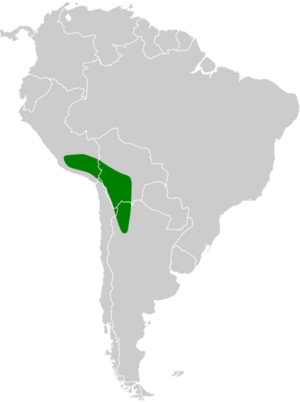Andean hillstar facts for kids
Quick facts for kids Andean hillstar |
|
|---|---|
 |
|
 |
|
| Male above, female below | |
| Conservation status | |
| Scientific classification | |
| Genus: |
Oreotrochilus
|
| Species: |
estella
|
 |
|
| Combined distribution (green) of Andean and green-headed hillstars in South America | |
The Andean hillstar (Oreotrochilus estella) is a type of hummingbird that lives in the high mountains of South America. You can find it in countries like Argentina, Bolivia, Chile, and Peru. It's known for living in very cold, high places.
Contents
About the Andean Hillstar Family
The Andean hillstar is part of a group of birds called "hillstars." Scientists use special names to classify animals. The Andean hillstar has two main types, or subspecies: O. e. estella and O. e. bolivianus.
For a while, another bird called the green-headed hillstar was thought to be a type of Andean hillstar. But in 2019, scientists decided it was its own separate species.
What Does the Andean Hillstar Look Like?
Andean hillstars are about 13 to 15 cm (5 to 6 in) long. Males usually weigh around 8.8 grams, and females are a bit lighter at 8.0 grams. They have a black beak that curves slightly downwards.
Male and Female Differences
- Males have dull brown feathers on their backs. Their throats are a shiny green, like a jewel, with a black border. This green patch is called a gorget. Their chests and bellies are white, with a reddish-brown stripe down the middle. Their tails are forked, with bronzy-black middle feathers and mostly white outer feathers with dark tips.
- Females are dull brown all over, even on their bellies. Their throats are pale with tiny dark spots. Their tails are greenish-black, with white at the base and tips of the outer feathers.
- Young males have a dark blue-green gorget.
The bolivianus subspecies of male Andean hillstars looks very similar to the main type. The only big difference is that the stripe on their belly is chestnut-colored with black spots.
Where Do Andean Hillstars Live?
These hummingbirds live high up in the central Andes mountains. The main type, O. e. estella, lives from southwestern Peru down through western Bolivia and northern Chile, reaching into northwestern Argentina. The O. e. bolivianus subspecies lives only in Bolivia's Cochabamba Department.
Their Mountain Home
Andean hillstars prefer puna grasslands, which are high-altitude grasslands. They especially like areas with lots of rocks. You might also see them near houses, among tall plants called Puya raimondii, or at the edges of Polylepis forests.
They live at elevations from 2,400 to 5,000 meters (7,900 to 16,400 ft) above sea level. They are most common between 3,500 and 4,500 meters (11,500 and 14,800 ft).
Surviving the Cold
Andean hillstars are amazing at handling cold nights and winter. They can slow down their body's functions, almost like hibernation, in a state called torpor. They do this in caves or deep cracks in rocks. This helps them save energy and stay safe from predators while they sleep.
How Do Andean Hillstars Behave?
Movement and Territory
During the time they raise their young, female Andean hillstars stay in areas near rocky outcrops. Males, however, fly around much more widely. Both males and females might move to slightly lower elevations during the colder winter months.
What Do They Eat?
Andean hillstars mostly drink nectar from various flowering shrubs, cacti, and trees. Unlike many hummingbirds, they often perch (sit) while they feed instead of hovering. This might be a way for them to save energy in their high-altitude home.
A shrub called Chuquiraga spinosa is very important to them. The Andean hillstar is its main pollinator, meaning it helps the plant reproduce. Besides nectar, these birds also eat small insects and spiders. They pick them off plants or sometimes catch them while flying.
Raising a Family
The breeding season for Andean hillstars is from September to February. Females build their nests in bushy areas with rocks, sometimes nesting close to other females.
Their nest is a large, woolly cup. They glue it to a rock face or sometimes build it under the "skirt" of a Puya raimondii plant. Females usually lay two eggs. The eggs hatch after about 20 days. The young birds are ready to leave the nest up to 38 days after hatching, depending on how warm it is. It's thought that they might lay two sets of eggs in one season.
What Sounds Do They Make?
The Andean hillstar makes a short, repeated "tsip" or "swit" sound. When they are chasing each other, they make a fast, musical, twittering sound.
How Are Andean Hillstars Doing?
The IUCN (International Union for Conservation of Nature) has listed the Andean hillstar as a species of "Least Concern." This means they are not currently in danger of disappearing. Even though we don't know the exact number of these birds, their population seems to be stable. They are one of the most common birds found in the puna grasslands and live in several protected areas.
External viewing
- Episode 2 of David Attenborough's "The Life of Birds", titled "Mastery of Flight".


